 |
| ACROPOLIS
The Acropolis was built on an extremely steep hill, approached by a winding road ascending some 300m. In this uniquely designed city, religious, official, social and commercial buildings are all found side-by-side. On top of this hill, which has been inhabited since ancient times, are the palaces of the King of Pergamum. |
|
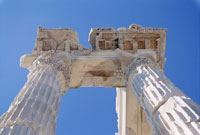 |
|
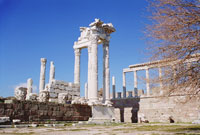 |
|
There are also five cisterns and an arsenal on the hill. Below these buildings is the Temple of Athena, as well as the Library and the Temple of Trajan. The Altar of Zeus was carefully placed below these buildings on a terrace. One of the steepest amphitheatres in the world is found here. The lowest section of the acropolis is the gymnasium and the Temple of Demeter. |
|
| Because of the topographical location of the city and the course of the main street, all the buildings of the acropolis are line up in a north-south fashion, but the buildings all face west so that they can be seen from far away. The Altar of Zeus was not encircled with colonnades for the same reason. The Agora and Athena Temple also have an unobstructed view of the plain. |
|
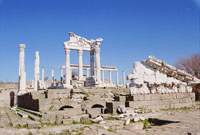 |
|
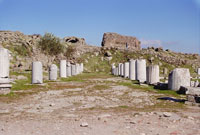 |
|
THE TEMPLE OF ATHENA
The temple columns and architrave pieces are still in Berlin. The fact that the city's most important temple is the Temple of Athena, as it is in Izmir, Miletus, Eriythrai, Foca and Assosas well, reflects the religious tradition of Western Anatolia. |
|
| Eumenes II had a two-storey covered walkway built along the length of the eastern and northern sides in the Hellenistic style, to commemorate his successful war against the Seleucids, Celts and Macedonians. |
|
| LIBRARY
Adjacent to the sacred site of the Temple of Athena, are the remains of the famous Pergamum library. The library, whose entrance used to be on the top floor of the gallery, dates back to the reign of Eumenes II and contains a magnificent reading room measuring 13.53 x 15.35 meters. |
|
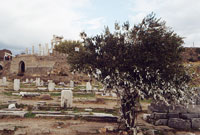 |
|
| Equipped with wooden shelves, the library also contained a 3.5m high statue of Athena, which is now in the Berlin Museum. During the reign of Eumenes II, the holding capacity of the library multiplied immensely, and its only equal in the world was the Library of Alexander. |
|
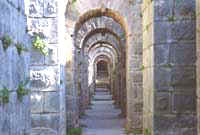 |
|
ARSENALS
The military arsenal is on the north end of the acropolis, on the other side of the palaces and the Trajaneun, approximately 10m downhill. There are five compartments, all parallel to one another. |
|
| TRAJANEUM
This, the highest terrace in the acropolis, was made for the Roman Emperor Trajan, who was declared to be divine and before that, there was undoubtedly a Hellenistic structure on this site. Measuring 68 x 58 m, the temple sits perched upon a high terrace surrounded on three sides by covered promenades. |
|
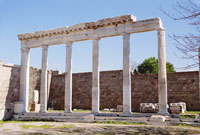 |
|
| Hadrian had the temple built for his predecessor Trajan, but it is known that both of the emperors were worshipped here because the colossal heads of statues of Trajan and Handrian honoring them were found here. These items are also on display in the Museum of Berlin. |
|
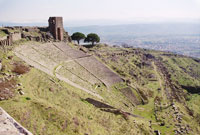 |
|
THEATER
Built on a very steep slope, the Pergamum theatre is one of the Hellenistic period's finest architectural achievements. The steepest amphitheatre in western Anatolia, it has a capacity of 10,000 people. In Hellenistic times the stage was made of wood; set up for the performances and then taken down again. |
|
| THE TEMPLE OF DIONYSOS
The people of Pergamum built this very alluring temple on the north side of the 250m- long theatre terrace, specifically so it would dominate the landscape of the area. This well-preserved temple with its beautiful profile and altar is a prostylos built upon a podium in the Ionic style. |
|
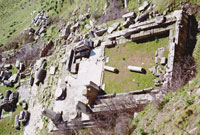 |
|
| This exquisite monumental structure with its distinctively Roman understanding of art, located at the end of a long road, was a big influence on the European Baroque school of architecture. The building underwent radical changes during the Roman era. The original Hellenistic and Roman pieces are in the Museum of Berlin. |
|
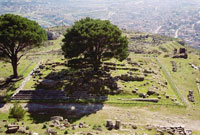 |
|
THE ALTAR OF ZEUS
Located about 25m below the lower terrace of the Temple of Athena, the altar was positioned at the very center of a 69m x 77m area. It is likely that the area was open on every side so that it could be easily seen for miles around. Its reliefs are not background ornaments, but play just as important role as the altar itself. |
|
| The altar, only the foundation of which is still in Pergamum, has been reconstructed and is today on display, with all of its reliefs, in the Berlin Museum. |
|
| UPPER AND LOWER AGORAS
The Agoras (Forum) are terraces located south of the Altar of Zeus and were built in the Hellenistic period in the style of Hermes, the god of commerce. Because of the levels of the surrounding land, the covered patios are three storeys on the outside, but only one inside. |
|
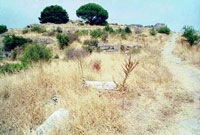 |
|
| The Upper Agora was once the focal point of social and commercial activities in the city, although little remains of it today. South of the gymnasium is the Lower Agora, work and homes of the common people. The main street of the city passed right through the middle of the Agora, and below is the Temple of Demeter, the place where rituals for a better after life were practiced. |
|
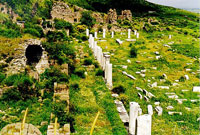 |
|
GYMNASIUM
The magnificent gymnasium of Pergamum was located on three terraces, one above the other. Inscriptions have been found which indicate that the floor for adults. The Upper Gymnasium is also known as the Ceremony Gymnasium. |
|
| All three of these gymnasiums were built during the dynastic period during the second half of the 3rd century BC. first floor was for children, the second floor for youth and the top. |
|
| ASCLEPION
Asclepion translates as 'place of Aesklepios', the son of Apollo and the god of healing and health, and was an important health center in Greco-Roman times. Among the types of therapy practiced here were mud baths, sports, theatre, psychotherapy and use of medicinal waters.
|
|
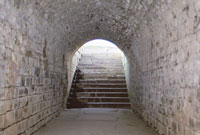 |
|
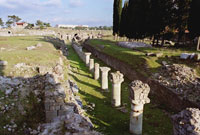 |
|
A colonnaded street leads to the Asclepion, and to the left of the entrance is the temple of Asclepios. This domed temple with its exceptionally thick 3m walls was built in 150 AD, with donations made to the god of health. The interior was decorated with colorful marble mosaics, and surrounded by galleries on three sides, the Asclepion has a passageway running through the center alongside the sacred spring towards the therapy building. |
|
| It is thought that patients were cured here by the sound of running water and by the persuasive hypnotic techniques used by the priests. |
|
| THE TEMPLE OF SERAPIS - THE RED BASILICA
The biggest structure and best-known attraction in the town is the Kizil Avlu (Red Basilica), a temple made of red brick dedicated to the gods of Egypt. The temple lies in what is now the modern day town of Bergama. The two pools in the temple with towers indicate ritual cleansing rites and a religious background that was neither Greek nor Roman. |
|
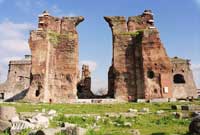 |
|
| The fact that it faces west, and is decorated with statues in an Egyptian style, indicates that it was possibly presented to Serapis, the Egyptian god of the underworld. In the Byzantine period, it was turned into a church by extensive remodeling, especially to the apse sections, and was dedicated to the St. John. |
|
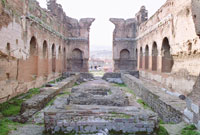 |
|
In early Christianity, it was one of the Seven Churches of Asia Minor addressed by St. John in the Book of Revelation, who referred to it as the throne of the Devil. Although a crumbling ruin, it still contains the remains of a mosque in one of the towers. |
|
|
 |
|
|
|